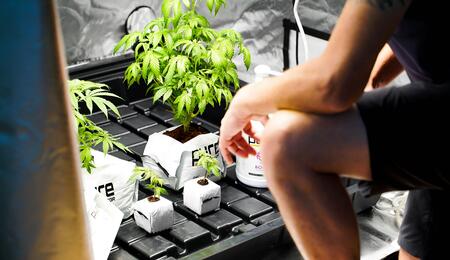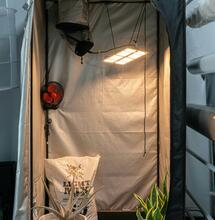EC and pH Explained

Establishing the correct EC and pH levels is crucial for maximizing plant growth. We often receive guidelines on what the ideal readings should be, but do you truly grasp their significance?
What is EC?
EC refers to electrical conductivity, which indicates how well a material can conduct electricity. Indoor cultivators typically measure nutrients in ounces per gallon or grams per liter. However, EC delves into more detail. Understanding EC and its importance is essential for growers. An ion represents an element in water, primarily composed of (feeding) salts that enable electricity conduction. A higher concentration of ions allows for a better flow of electrons. Adding nutrients to water increases its conductive capacity, thereby raising the EC value.
Pure or distilled water lacks minerals and has no ability to conduct electricity. When mineral nutrients are introduced, the dissolved salts enable conductivity. This measurement provides insight into nutrient availability in the water. EC indicates the quantity of accessible nutrients.
What EC do your plants need?
The necessary EC level depends on the type of plant. For most plants, the EC should be in the range of 1.2 to 1.6 during the vegetative phase and between 1.6 and 2.4 during the flowering stage. Tomatoes can tolerate an EC level of up to 2.8, while spinach can handle levels as high as 3.5. Conversely, basil should not exceed an EC of 1.4.
Why is EC important?
Regular EC measurement provides a clear understanding of the nutrient feed's status. Over time, your EC may fluctuate, so consistent monitoring is necessary.
EC stays the same
This indicates that the plant is utilizing equal amounts of water and nutrients, showing balance.
EC goes down
A decrease suggests that the plant is consuming more nutrients than water. You may need to use a stronger nutrient solution.
EC goes up
An increase implies that the plant is using more water than nutrients, indicating it isn't taking up what is necessary. Dilute the solution further by adding water. Temperature can also play a role; on warmer days, plants might absorb more water.
What to remember with EC
While EC measures the available nutrient quantity, it does not specify how much of each nutrient is present. Certain elements may accumulate to levels that can harm your plants. Therefore, achieving the ideal EC measurement does not necessarily prevent nutrient deficiencies. It's essential to replenish nutrients as required and perform a complete nutrient refresh every week, especially if you are using a reservoir or tank.
Measuring EC?
The most efficient method for measuring EC is with a digital meter. EC meters gauge electrical conductivity through electrodes. Simply place the meter's end into your feed solution and check the digital readout for your results.
Measuring EC regularly is vital for monitoring conditions. Changes can occur rapidly, so it's best to detect issues as early as possible. To ensure accurate readings, clean and calibrate your EC meter frequently.
What is pH?
pH denotes the potential of hydrogen and serves as an indicator of a substance's acidity or alkalinity. It is measured on a scale of 14, ranging from zero (most acidic) to 14 (most alkaline). Both acids and bases can be hazardous at their extremes, often reacting violently with organic matter, causing burns or dissolving tissue. The pH level in your growing medium can significantly affect your plants' growth and development.
Many plants thrive in slightly acidic soil, ideally between 5.5 and 6.5. Always verify your plant's specific requirements for optimal results. Maintaining a mildly acidic pH enables nutrient absorption, including nitrogen, phosphorus, and potassium—key elements for growth and flowering. Proper pH levels ensure that all fertilization and media maintenance function effectively. If the media's acidity is off, it disrupts the entire balance.
How do you measure soil pH?
Checking pH is straightforward. There are various testing kits available, such as paper strips, tablets, and electronic readers that can simultaneously assess EC and pH. Each kit comes with instructions, but generally, you'll mix a soil sample with dechlorinated water (pure water has a neutral pH of 7). Insert your testing method, and the test will either change color or provide another indication of the pH based on the kit instructions. Compare your results to determine your soil's pH.
Correcting pH
After recognizing the significance of pH, the next question is how to adjust it if it's incorrect. The solution is to add more acid or alkaline to your growing medium. You can use products labeled "pH UP" or "pH DOWN," which are specifically formulated to adjust pH levels without harming your plants. Measure the recommended amount and incorporate it into your feed prior to watering.
The benefits of monitoring EC and pH.
Most growers lack a proactive approach to prevent nutrient issues. Regularly monitoring the EC and pH of the growing medium can help avoid nutrient problems. It also shows the availability of all macro-and micronutrients.
Addressing nutritional issues only when they arise is not the best strategy. You may find it difficult to undo any damage that has been done. By monitoring pH and EC, you can avert these problems. Maintaining plants in optimal condition increases their resilience against pests and diseases. Observing the pH and EC levels in the growing medium is an excellent proactive method for avoiding nutritional issues. It enables you to identify potential concerns before they impact plant growth and quality. Numerous products are available to help you manage your EC and pH levels effectively.
More From Soft Secrets:



.png)
